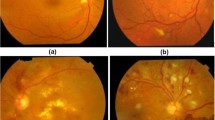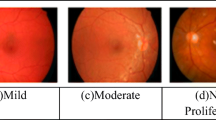Abstract
One of the common diseases in people with micro aneurysms is diabetic retinopathy (DR). Due to a lack of early diagnosis, diabetic retinopathy poses a risk to vision because it develops without any warning symptoms. Therefore, the deep learning methods on color fundus images demonstrate the recognition task of diabetic retinopathy levels. In this manuscript, an automated Micro aneurysm detection and classification utilizing deep convolution spike neural network (DCSNN-AMA) is proposed for diabetic retinopathy. Here, the images are filtered using Savitzky-Golay (SG) pre-processing method. After preprocessing, the images are segmented under Tsalli's Entropy based multilevel 3D Otsu (TE-3D-Otsu) thresholding technique. The images are extracted under Gray level co-occurrence matrix (GLCM) window adaptive algorithm operation. After that, the Deep Convolutional Spiking Neural Network (DCSNN) method is employed for classification. The proposed method has attained 32.5, 19 and 24.4% higher accuracy, 23, 31.6 and 24.4% higher F-measure, and 19.35, 8 and 16.12% lower computation time analyzed to the existing models.





Similar content being viewed by others
References
Glovaci, D., Fan, W., & Wong, N. D. (2019). Epidemiology of diabetes mellitus and cardiovascular disease. Current cardiology reports, 21(4), 1–8.
Zhang, B., Liu, L., Guo, L., Guo, S., Zhao, X., Liu, G., & Yang, J. (2021). Telomere length mediates the association between polycyclic aromatic hydrocarbons exposure and abnormal glucose level among Chinese coke oven plant workers. Chemosphere, 266, 129111.
Sivapriya, G., Devi, R. M., Keerthika, P., & Praveen, V. (2024). Automated diagnostic classification of diabetic retinopathy with microvascular structure of fundus images using deep learning method. Biomedical Signal Processing and Control, 88, 105616.
Gadekallu, T. R., Khare, N., Bhattacharya, S., Singh, S., Maddikunta, P. K. R., & Srivastava, G. (2020). Deep neural networks to predict diabetic retinopathy. Journal of Ambient Intelligence and Humanized Computing. https://doi.org/10.1007/s12652-020-01963-7
Mesquida, M., Drawnel, F., & Fauser, S. (2019). The role of inflammation in diabetic eye disease. Seminars in Immunopathology, 41(4), 427–445.
Jain, P., & Gupta, S. (2023). Evolutionary gravitational neocognitron neural network based blood flow velocity prediction using multi-exposure laser speckle contrast imaging. International Journal of Pattern Recognition and Artificial Intelligence. https://doi.org/10.1142/S0218001423560232
Nagarani, N., Karthick, R., Sophia, M. S. C., & Binda, M. B. (2024). Self-attention based progressive generative adversarial network optimized with momentum search optimization algorithm for classification of brain tumor on MRI image. Biomedical Signal Processing and Control, 88, 105597.
Reka, R., Karthick, R., Ram, R. S., & Singh, G. (2024). Multi head self-attention gated graph convolutional network based multi attack intrusion detection in MANET. Computers & Security, 136, 103526.
Meenalochini, P., Karthick, R., & Sakthivel, E. (2023). An Efficient control strategy for an extended switched coupled inductor Quasi-Z-Source inverter for 3 Φ Grid connected system. Journal of Circuits, Systems and Computers, 32(11), 2450011.
Karthick, R., Senthilselvi, A., Meenalochini, P., & Senthil Pandi, S. (2023). An optimal partitioning and floor planning for VLSI circuit design based on a hybrid bio-inspired whale optimization and adaptive bird swarm optimization (WO-ABSO) algorithm. Journal of Circuits, Systems and Computers, 32(08), 2350273.
Chandran, J. G. J., Karthick, R., Rajagopal, R., & Meenalochini, P. (2023). Dual-channel capsule generative adversarial network optimized with golden eagle optimization for pediatric bone age assessment from hand X-ray image. International Journal of Pattern Recognition and Artificial Intelligence, 37(02), 2354001.
Rajagopal, R. K. P. M. T. K. R., Karthick, R., Meenalochini, P., & Kalaichelvi, T. (2023). Deep Convolutional Spiking Neural Network optimized with Arithmetic optimization algorithm for lung disease detection using chest X-ray images. Biomedical Signal Processing and Control, 79, 104197.
Karthick, R., & Meenalochini, P. (2020). Implementation of data cache block (DCB) in shared processor using fi eld-programmable gate array (FPGA).
Karthick, R., Senthilselvi, A., Meenalochini, P., & Senthil Pandi, S. (2022). Design and analysis of linear phase finite impulse response filter using water strider optimization algorithm in FPGA. Circuits, Systems, and Signal Processing, 41(9), 5254–5282.
https://www.adcis.net/en/third-party/e-ophtha/
Jardim, R., & Morgado-Dias, F. (2020). Savitzky-Golay filtering as image noise reduction with sharp color reset. Microprocessors and Microsystems, 74, 103006.
Jena, B., Naik, M. K., Panda, R., & Abraham, A. (2021). Maximum 3D Tsallis entropy based multilevel thresholding of brain MR image using attacking Manta Ray foraging optimization. Engineering Applications of Artificial Intelligence, 103, 104293.
Chen, H., Li, W., & Zhu, Y. (2021). Improved window adaptive gray level co-occurrence matrix for extraction and analysis of texture characteristics of pulmonary nodules. Computer Methods and Programs in Biomedicine, 208, 106263.
Turkson, R. E., Qu, H., Mawuli, C. B., & Eghan, M. J. (2021). Classification of alzheimer’s disease using deep convolutional spiking neural network. Neural Processing Letters, 53(4), 2649–2663.
Mazlan, N., Yazid, H., Arof, H., & Mohd Isa, H. (2020). Automated microaneurysms detection and classification using multilevel thresholding and multilayer perceptron. Journal of Medical and Biological Engineering, 40(2), 292–306.
Usman, I., & Almejalli, K. A. (2020). Intelligent automated detection of microaneurysms in fundus images using feature-set tuning. IEEE Access, 8, 65187–65196.
Shankar, K., Sait, A. R. W., Gupta, D., Lakshmanaprabu, S. K., Khanna, A., & Pandey, H. M. (2020). Automated detection and classification of fundus diabetic retinopathy images using synergic deep learning model. Pattern Recognition Letters, 133, 210–216.
Alaguselvi, R., & Murugan, K. (2021). Performance analysis of automated lesion detection of diabetic retinopathy using morphological operation. Signal, Image and Video Processing, 15(4), 797–805.
Murugan, R., & Roy, P. (2022). MicroNet: Microaneurysm detection in retinal fundus images using convolutional neural network. Soft Computing, 26(3), 1057–1066.
Das, S., & Saha, S. K. (2022). Diabetic retinopathy detection and classification using CNN tuned by genetic algorithm. Multimedia Tools and Applications, 81(6), 8007–8020.
Avinash, A., Biju, P., Premanath, P., Thomas, A., & Gopi, V. P. (2022). An improved method for automated detection of microaneurysm in retinal fundus images. In R. Sridhar, G. R. Gangadharan, M. Sheng, & R. Shankaran (Eds.), Edge of things in personalized healthcare support systems (pp. 173–186). London: Academic Press.
Sahoo, M., Ghorai, S., Mitra, M., & Pal, S. (2023). Improved detection accuracy of red lesions in retinal fundus images with superlearning approach. Photodiagnosis and Photodynamic Therapy, 42, 103351.
Liao, Y., Xia, H., Song, S., & Li, H. (2021). Microaneurysm detection in fundus images based on a novel end-to-end convolutional neural network. Biocybernetics and Biomedical Engineering, 41(2), 589–604.
Birlin, T. M., Divya, C., & Livingston, J. J. (2023). Automatic detection of microaneurysms using a novel segmentation algorithm based on deep learning techniques. Computational Intelligence. https://doi.org/10.1111/coin.12588
Pavani, P. G., Biswal, B., & Gandhi, T. K. (2023). Simultaneous multiclass retinal lesion segmentation using fully automated RILBP-YNet in diabetic retinopathy. Biomedical Signal Processing and Control, 86, 105205.
Balaji, G. N., Mary, S. A. S. A., Mantravadi, N., & Shajin, F. H. (2023). Graph CNN-ResNet-CSOA transfer learning architype for an enhanced skin cancer detection and classification scheme in medical image processing. International Journal on Artificial Intelligence Tools. https://doi.org/10.1142/S021821302350063X
Funding
None.
Author information
Authors and Affiliations
Contributions
Dr. Vidhyalakshmi M.K: Conceptualization, Methodology, Writing- Original draft preparation. Dr. Thaiyalnayaki S: Supervision. Dr. Bhuvana Suganthi D: Supervision. Dr. Porselvi R: Supervision. Mrs. Kumuthapriya K: Supervision.
Corresponding author
Additional information
Publisher's Note
Springer Nature remains neutral with regard to jurisdictional claims in published maps and institutional affiliations.
Rights and permissions
Springer Nature or its licensor (e.g. a society or other partner) holds exclusive rights to this article under a publishing agreement with the author(s) or other rightsholder(s); author self-archiving of the accepted manuscript version of this article is solely governed by the terms of such publishing agreement and applicable law.
About this article
Cite this article
Vidhyalakshmi, M.K., Thaiyalnayaki, S., Suganthi, D.B. et al. Automated micro aneurysm classification using deep convolutional spike neural networks. Wireless Netw 31, 505–515 (2025). https://doi.org/10.1007/s11276-024-03769-3
Accepted:
Published:
Issue Date:
DOI: https://doi.org/10.1007/s11276-024-03769-3




